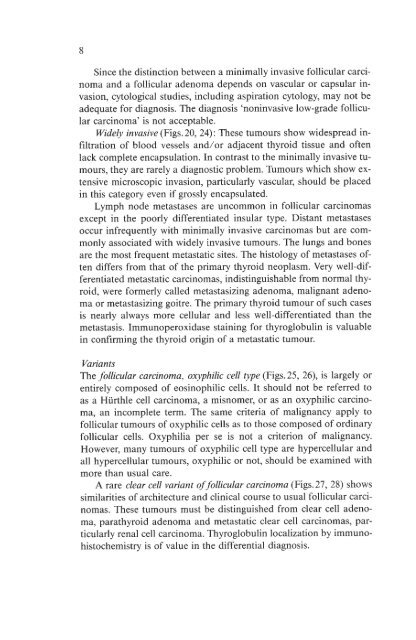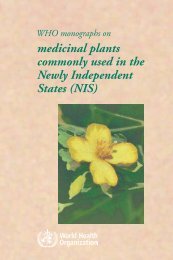Histological Typing of Thyroid Tumours - libdoc.who.int - World ...
Histological Typing of Thyroid Tumours - libdoc.who.int - World ...
Histological Typing of Thyroid Tumours - libdoc.who.int - World ...
You also want an ePaper? Increase the reach of your titles
YUMPU automatically turns print PDFs into web optimized ePapers that Google loves.
8<br />
Since the distinction between a minimally invasive follicular carcinoma<br />
and a follicular adenoma depends on vascular or capsular invasion,<br />
qtological studies, including aspiration cytology, may not be<br />
adequate for diagnosis. The diagnosis<br />
'noninvasive low-grade follicular<br />
carcinoma' is not acceptable.<br />
Widely invasive (Figs.20,24): These tumours show widespread infiltration<br />
<strong>of</strong> blood vessels and/or adjacent thyroid tissue and <strong>of</strong>ten<br />
lack complete encapsulation. In contrast to the minimally invasive tumours,<br />
they are rarely a diagnostic problem. <strong>Tumours</strong> which show extensive<br />
microscopic invasion, particularly vascular, should be placed<br />
in this category even if grossly encapsulated.<br />
Lymph node metastases are uncommon in follicular carcinomas<br />
except in the poorly differentiated insular type. Distant metastases<br />
occur infrequently with minimally invasive carcinomas but are commonly<br />
associated with widely invasive tumours. The lungs and bones<br />
are the most frequent metastatic sites. The histology <strong>of</strong> metastases <strong>of</strong>ten<br />
differs from that <strong>of</strong> the primary thyroid neoplasm. Very well-differentiated<br />
metastatic carcinomas, indistinguishable from normal thyroid,<br />
were formerly called metastasizing adenoma, malignant adenoma<br />
or metastasizingoitre. The primary thyroid tumour <strong>of</strong> such cases<br />
is nearly always more cellular and less well-differentiated than the<br />
metastasis. Immunoperoxidase staining for thyroglobulin is valuable<br />
in confirming the thyroid origin <strong>of</strong> a metastatic tumour.<br />
Variants<br />
The follicular carcinoma, oxyphilic cell type (Figs.25, 26), is largely or<br />
entirely composed <strong>of</strong> eosinophilic cells. It should not be referred to<br />
as a Hiirthle cell carcinoma, a misnomer, or as an oxyphilic carcinoma,<br />
an incomplete term. The same criteria <strong>of</strong> malignancy apply to<br />
follicular tumours <strong>of</strong> oxyphilic cells as to those composed <strong>of</strong> ordinary<br />
follicular cells. Oxyphilia per se is not a criterion <strong>of</strong> malignancy.<br />
However, many tumours <strong>of</strong> oxyphilic cell type are hypercellular and<br />
all hypercellular tumours, oxyphilic or not, should be examined with<br />
more than usual care.<br />
A rare clear cell variant <strong>of</strong> follicular carcinoma(Figs.2l,28) shows<br />
similarities <strong>of</strong> architecture and clinical course to usual follicular carcinomas.<br />
These tumours must be distinguished from clear cell adenoma,<br />
parathyroid adenoma and metastatic clear cell carcinomas, particularly<br />
renal cell carcinoma. Thyroglobulin localization by immunohistochemistry<br />
is <strong>of</strong> value in the differential diagnosis.
















